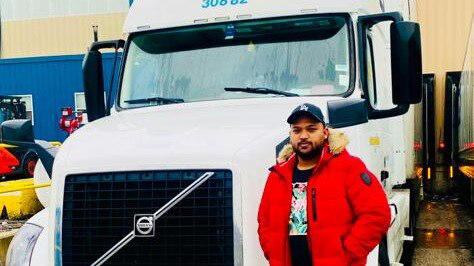Purva didn’t have any plans to go to Canada. The 29-year-old software engineer was doing well in the IT industry and had a comfortable life in India. Purva isn’t her real name, but while narrating her Canada experience, she prefers to conceal her identity.
Purva reached Canada after her marriage. And it has been quite a journey from Pune to Kitchener, from being an employee of Infosys and Mastek in India, to a factory worker at an automobile engine plant in Canada.
Contrast this with the story of 33-year-old Ravish Garg. An under-graduate from Kapurthala in Punjab, Ravish moved to Canada in 2012 on a study visa. He studied for two years and then opted to work as a truck driver.
In 10 years, Ravish has gone on to own three trucks and a house in Brampton. He is happily married and is pursuing a bigger dream of establishing a full-fledged logistics and transport company in Canada.
Purva and Ravish, who we will get to know better subsequently, are two sides of the same coin — classic examples of the struggles and successes of Indians in Canada. Their stories also tell us what is now wrong with the Canadian dream. How there’s a mismatch in aspirations, education and job opportunities.
And the problem is getting compounded as Canada opens doors for immigrants. This year, Canada is on track to welcome 500,000 permanent residents on top of a staggering 900,000 international students. In 2022, Indians formed 40 per cent of the international students in Canada.
The route to citizenship is cheaper, easier and faster in Canada in comparison to other western countries. And Indians are increasingly taking the study visa route. But what is to be kept in mind is that most of the courses offered by the private Canadian colleges aren’t job-oriented. Canada’s economy isn’t growing and there is a dearth of white-collar jobs and an availability of blue-collar jobs.
“It is unfortunate that many diploma-churning mills do not offer future-ready courses which can otherwise assist the students to secure quality jobs, fill in vacancies and at the same time achieve permanent residency much easily,” Manan Gupta, Canada-based registered immigration consultant, tells IndiaToday.In.
“Blue-collar jobs are in demand as Canadian-born millennials are shying away from jobs like truck driving, technicians, plumbers, electricians and welders among others,” says Gupta.
Purva didn’t plan to be in Canada. The thought was drilled into her head by a friend who stayed in her gated society in Pune.
“She wanted to be in Canada because of the lifestyle that the country has to offer and she wanted me to be part of her plan as her parents were conservative. Now, I am here but she never made it,” Purva tells IndiaToday.In on a call from Kitchener.
Purva applied for a study visa in Canada even as she was working with Mastek. She had already put in 3 years with Infosys and was earning Rs 85,000 per month. Simultaneously, she also put up her profile on a Maharashtrian matrimonial website.
As her profile mentioned that she had applied for a study visa in Canada, the interested matches were those who were already in Canada or who planned to be there. Purva got married in June 2022 to a person who was on a work visa in Canada. She reached Canada in February this year on a dependent visa.
She was finally with her husband but it wasn’t the honeymoon period that she had expected.
The housing crisis-fuelled high rents got them to move to a basement and shell out $1,250 per month for it.
“My husband works as a quality inspector with an annual income of around $60,000, which just about takes care of our rent, grocery and essentials,” says Purva. So, she started looking for a job so that they could save some money and go on short holidays.
“For five months, I kept looking for IT jobs as I had experience in that field but nothing materialized. Finally, I had to take up a job as a worker in a manufacturing plant that produces automobile engines and earn $19 an hour. Had I got an IT job, I would have made $35 an hour,” she says.
Other than the pay and the job she would like, she has no problem working on the factory line. There is no looking down upon any professional or profession.
“There is a dignity of labour and every job is treated with respect and a harassment-free working atmosphere,” says Manan Gupta, adding, “Anyone wishing to settle down in Canada needs to have an open-minded, hard-working attitude to maximise on their potential.”
Indian youths, says Manan Gupta, are primarily getting into the supply chain sector with a focus on truck driving jobs, fulfilment centres and warehousing, ride sharing and food delivery apps among other blue-collar professions. Indian students are an essential part of Canada’s gig economy.


